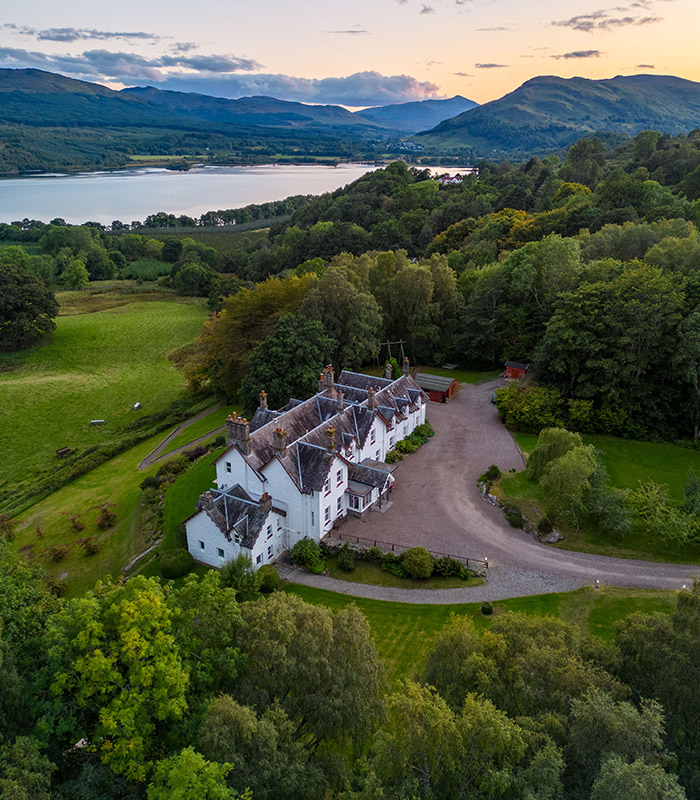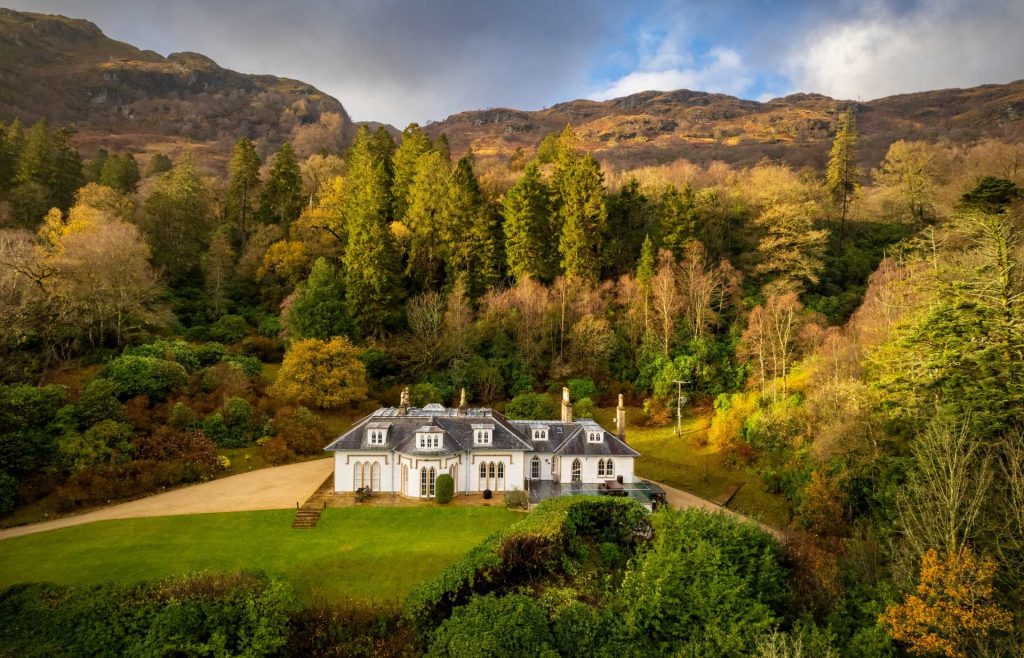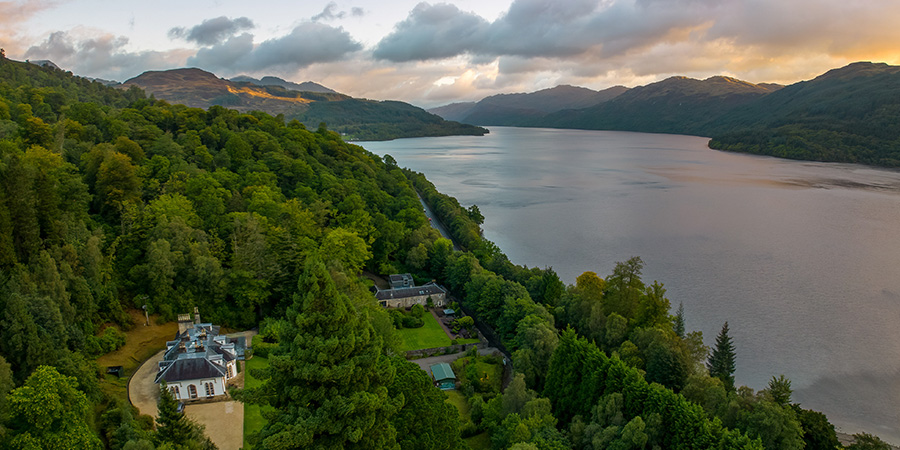Scottish wedding traditions
Scotland is a country steeped in traditions, as well as being known for its history, clans, tartans and dramatic scenery. It’s no wonder that lots of couples near and far want to enjoy a proper Scottish wedding. Are you getting married in Scotland? Looking for some Scottish wedding traditions to add to your day? Well, here we look forward to sharing with you some Scottish wedding inspiration.
Historic estates in clan lands
But before we do, let us introduce you to our 3 magnificent, historic, grand, Scottish houses. Firstly, see our two properties set on the banks of Loch Lomond, Stuckgowan and Stuckdarrach. And then the largest overlooking Loch Tay, Stucktaymore. The ideal luxury properties for a private Scottish wedding in beautiful surroundings.
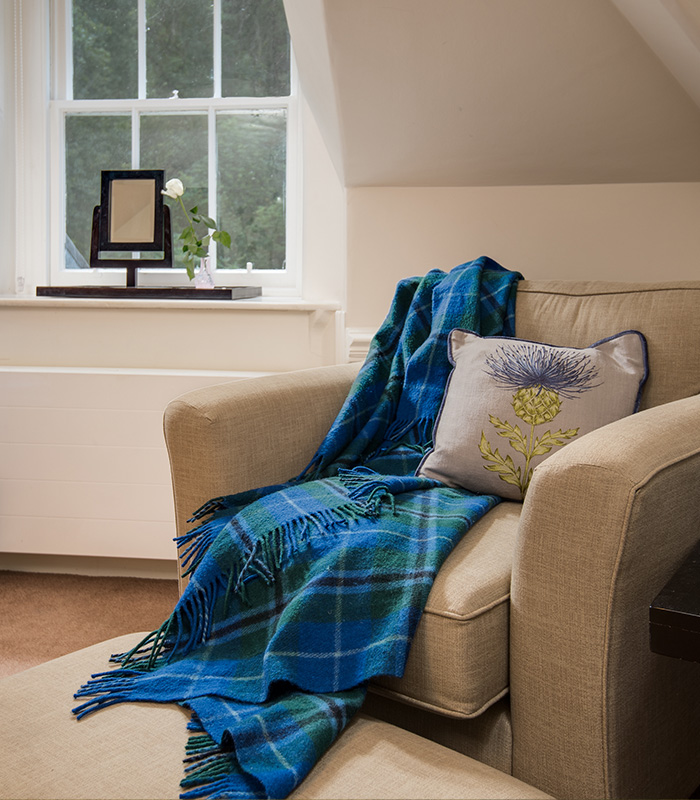
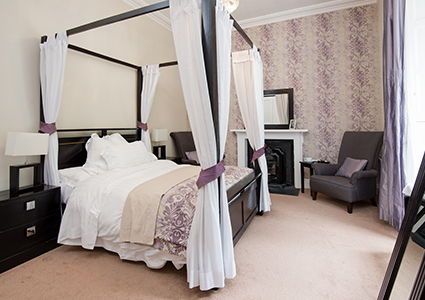
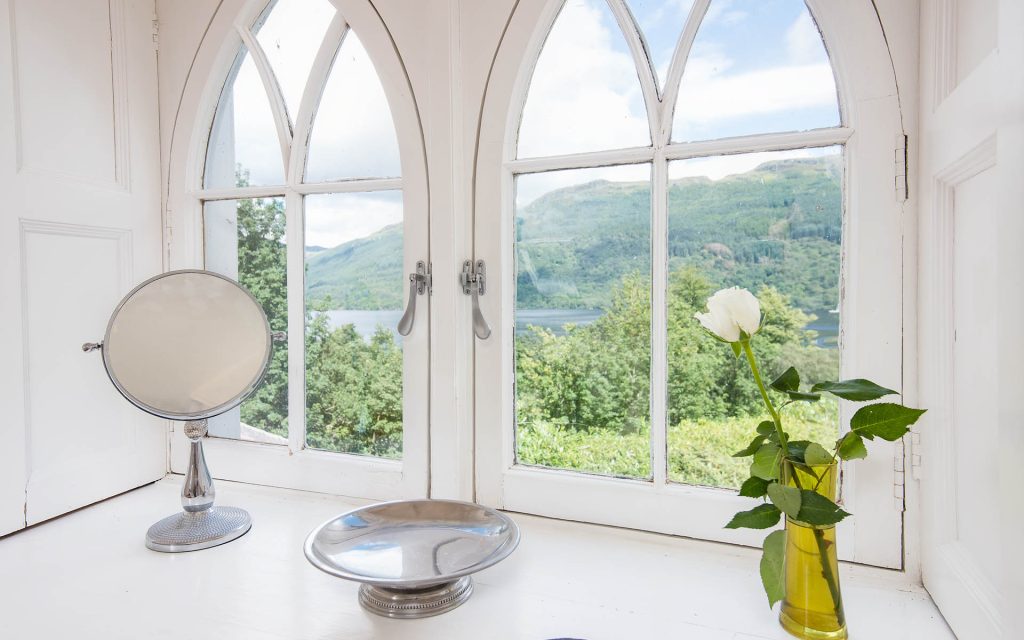
What to wear to your Scottish Wedding
At your Scottish wedding, you might be wondering what Scottish touches to add to your day. Often our Scots brides and grooms, and their wedding parties, will wear beautiful thistles and white Scottish heather. Thistles are our national flower and the white heather symbolises luck and good fortune. Both are readily available from our local florists, who will make them into stunning traditional Scottish wedding bouquets, corsages and buttonholes.
Adding a touch of tartan to your dress is also popular in Scotland. Be this in the dress design, as a scarf – dropped over the shoulder and pinned around the bride’s waist, or as a shall. Men would always come to the wedding in their finest kilt, complete with sporran and a Sgian-dubh (pronounced skee-an-du), a small sword, tucked in their right sock.
The Scots were, and still are, very superstitious. As such, many of our Scots traditions are based around keeping the bride and groom safe. So the Scottish bride will follow many ancient superstitions, such as the wearing of a lucky sixpence (an old Scots coin) in her shoe for good luck and prosperity. And, ensuring she leaves her home, stepping out with her right foot first. Stepping out with the left foot was said to bring bad luck. Possibly where the phrase ‘getting off on the right foot’ comes from.
Scottish traditions for before your wedding
A Scottish Luckenbooth brooch
With two hearts intertwined, this is a beautiful Scots wedding tradition. One where y our groom will you a love brooch… Or a Luckenbooth Brooch. This can be made of silver, and sometimes with precious stones. The brooch should comprise two intertwined hearts with a crown at the top. This symbol of love is then given by the groom to his bride to wear on her wedding day. And then if you go on to have children, the Scottish tradition is to then attach the Luckenbooth to your first baby’s blanket. The word Luckenbooth comes from an old Scots word for “lockable stall” and the brooch is believed to ward off evil spirits.
19th Century Scottland, Creeling
Until the start of the 19th Century, Creeling the Bridegroom was a common Highland Scottish wedding tradition. This is a unique Scots wedding tradition where the groom carries a large basket (a creel) of stones, on his back, around his local village. And for fun, his friends wouldn’t let him stop or put them down until his bride ran out of her house to kiss him.
In southern Scotland, this tradition was slightly different. where, after the ceremony, the bride and groom would cut a ribbon on a basket, which would tied to the church door. As the basket falls to the floor, it is said to bring the married couple health and wealth for their future together.
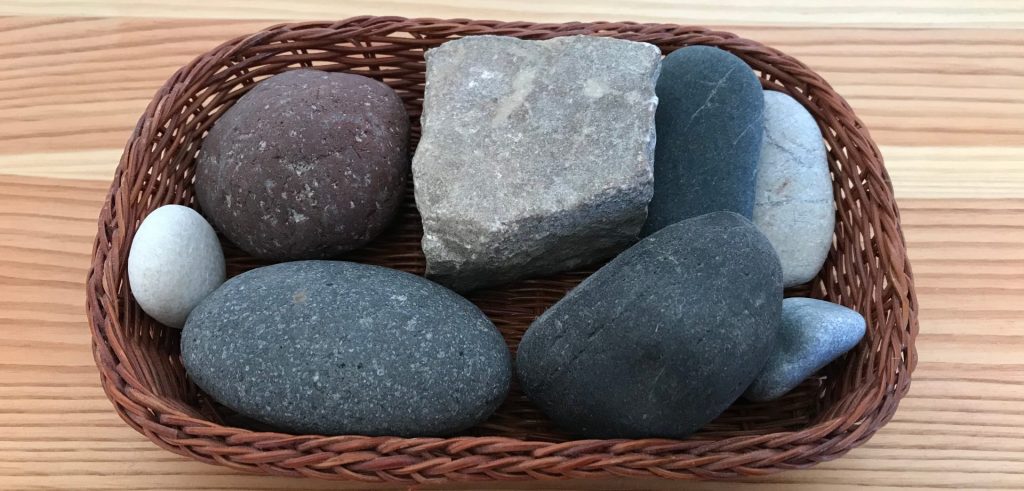
Feet washing
Another wonderful Scots wedding tradition, most common in Fife, Dundee and Angus. The washing of the bride’s feet! On the morning of your wedding, the bride is to have her feet washed and dried by an older, happily married woman of the bridal party. We like to think that this was an opportunity for the new bride to hear some wisdom from the older woman on marriage. Plus, the foot washer is expected to drop a ring into the water for some excitement. Here the single women of the bridal party then have to rush to find it. And the finder of the ring is then set to be the next one to get married. This is rather similar to our other tradition of tossing the bridal bouquet.
Scottish wedding ceremony traditions
The wedding march or wedding walk
This is another fabulous Scottish wedding tradition that we love! Here the wedding party walk to the church or ceremony together. It’s a lively event, being accompanied by a Scottish bagpiper, or a fiddle player. And against the current tradition of not seeing each other until the ceremony, so perfect for those who want to be together on their arrival. Here the groom leads the march, escorted by the chief bridesmaid. He is followed by his bride, escorted by the best man with the rest of the wedding party behind. After the ceremony, the newlyweds leave the church followed by the best man and the chief bridesmaid. The rest of the wedding party follows after.
Ancient Scots ceremonies “at the door”
One of the oldest Scots wedding traditions, and one less heard of today, is where the bride and groom say their vows outside the front entrance of the Kirk (church). And then, once they have exchanged their vows, they then enter the church for the rest of the wedding ceremony, including handfasting.
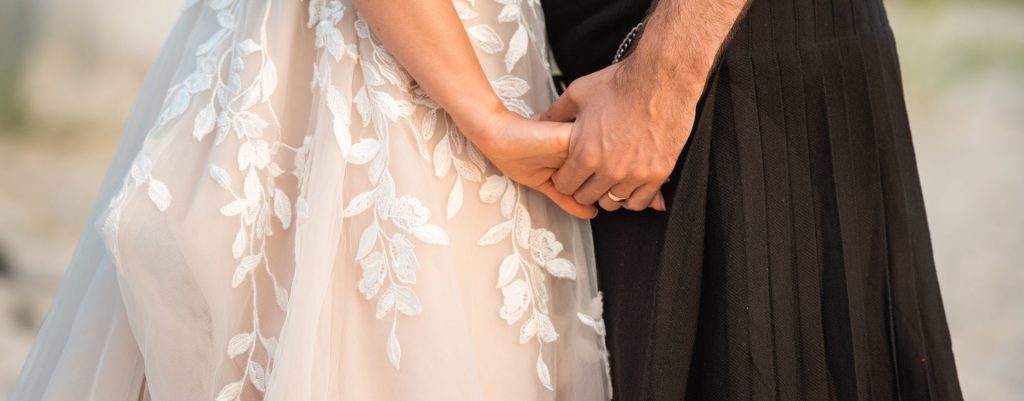
Handfasting
Handfasting is a Celtic tradition that was held to mark a temporary marriage. In rural areas, a priest might not visit a village for months at a time. Some couples didn’t want to wait to be married so, as long as the couple declared their love for each other in the presence of witnesses, it was legally binding.
As part of the handfasting ceremony, the bride and groom take a piece of their clan’s tartan and tie their hands together, joining them and their families. This is where the phrase ‘tying the knot’ comes from!
Protecting the bride
Did you know there is a reason to the bride and groom’s stance? This is so that the groom can defend his bride should he need to. As such, brides today still stand on the left of the groom in the church. This is so his right hand is free to use his dirk (short sword) to fight off any other suitors. He may even need to fight his new ‘in-laws’ should they object to the union!
Although modern-day grooms rarely have to fight other suitors or their new in-laws, the bride still stands on the left of him in church.
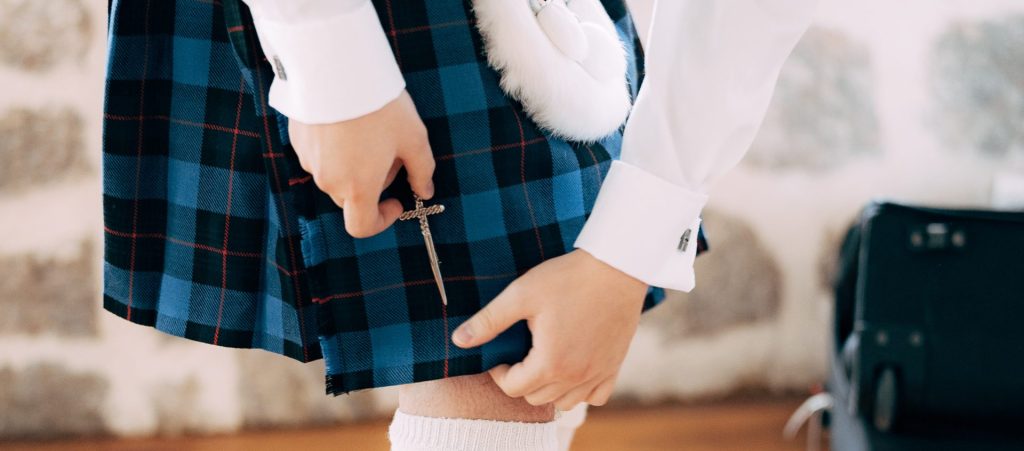
Swearing an oath
Have you heard the saying ‘set in stone’? When an oath is given over stone or water, it is said to be binding. Therefore, couples would say their vows over a stone to make their marriage oaths stronger. In some parts of Scotland, the couple also carved their names into the bark of a tree or onto a stone. The oathing stone tradition is still loosely followed today with some couples joining hands on a stone as they say their vows.
The Circle and the Caim
Here the couple draws a circle around themselves on the ground. Once their circle of love is complete, they repeat a prayer of protection together. This ancient Scots prayer is called “the Caim”. The Scottish Gaelic word “Caim” means: “Sanctuary, an invisible circle of protection drawn around the body with the hand to remind one of being safe and loved, even in the darkest time”. This lovely Scottish prayer and the circle symbolise the unity of the bride and groom. Here’s an example:
The Mighty Three, my protection be, encircle me.
You are around my life, my love, my home.
Encircle me. O sacred three, the Mighty Thee.

Groom’s Siller
Siller means Silver. And when we Scots say Siller, we mean money! Scottish grooms were expected to bring 13 silver coins to their wedding, to give to the minister marrying him and his bride. The minister then drops the coins back onto the groom’s palm as a gift to bring the couple prosperity. Finally, the groom drops the coins in his bride’s palm, before she drops them back to him. The sharing of wealth, provision for each other and the saving/keeping of money and wise management.
Lucky horseshoes
Another old Scots tradition, that carries on today, is for a toddler or child to present the bride with a horseshoe for good luck. The horseshoe must be held with the toe of the shoe to the ground. If the ends of the shoe point down, it is thought that the luck would run out. As such, many of these gifts have a tartan ribbon tied to the end nail hole of the shoe on each side… So it can be carried easily and not dropped.
Scottish wedding traditions after you are married
Pinning the tartan
Do you have a clan tartan? If you don’t you can pick your favourite, but traditionally all Scots had a tartan. The Pinnin of the Tartan was seen as the acceptance of each spouse into the other spouse’s family – as they married into new clans. This may be a ribbon, rosette or crest of each clan’s family’s tartan.
Traditional Scottish wedding cakes
Why not step back in time, and organise a traditional Scottish wedding cake? This is a two-layered fruit cake soaked in brandy. Traditionally this is baked when the couple announced their engagement. At the wedding, the bottom tier would be served to the guests of the families to signify the couple’s union. Then the second tier would be saved to celebrate the birth of their first child together.
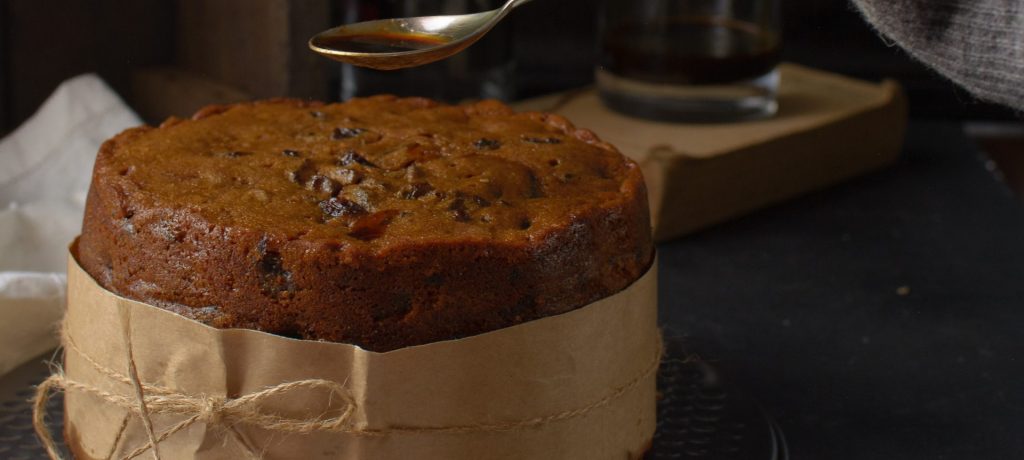
Sharing of the Quaich
This tradition can be carried out by the top table only, or if you are hosting a small Scottish wedding, the entire wedding party! Here a Quaich (a two-handled lovers’ cup) is shared by all at the wedding dinner, or “feast”. The bride is announced, stands up and fills the Quaich with whisky. She then takes a sip and passes it on to her groom. it is then passed to all in the wedding party or family. Each takes a sip in turn to signify the union of the two clans. In ancient Scottish times, the Quaich would be made of wood, sometimes with metal embellishments. Today, they are generally made of silver and given as wedding or anniversary gifts.
The wedding scramble
The wedding scramble today is still a very popular Scottish wedding tradition. Here the father of the bride throws coins into the air for kids to scramble upon (and collect as many as they possibly can). This happens as the bride and groom leave the wedding party for their first evening together. It is said to bring the couple a strong financial future, and distracts the children from the leaving of the bride and groom!
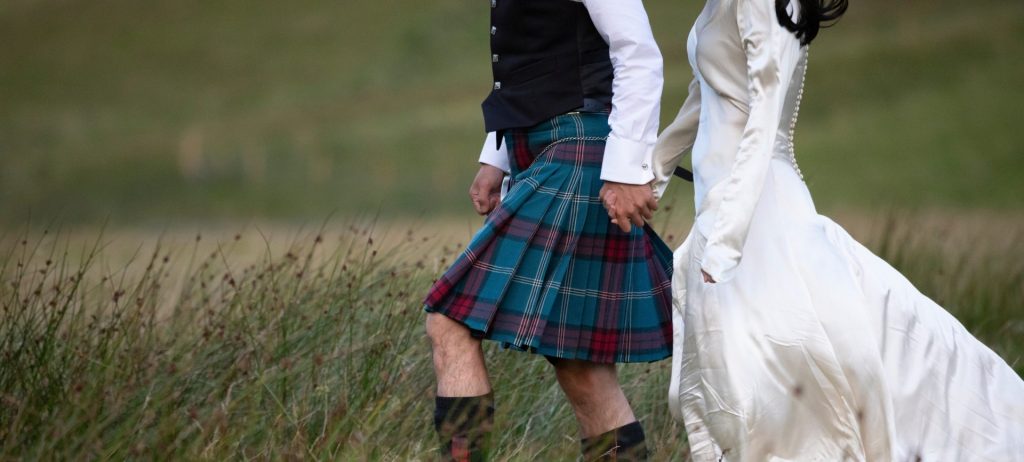
Now that you have some inspiration for your wedding with our Scottish wedding traditions, what better way to set the scene for your wedding than on a grand Scottish country estate? Each of our 3 big Scottish country estate houses offers the perfect private setting for your wedding day.
Overlooking the famous Lomond, in prime clan lands are our Stuckgowan and Stuckdarrach properties. Stuckgowan can host up to 19 guests in a grand setting fit for a Scottish laird. Stuckdarrach is ideal for smaller micro weddings and elopement weddings, hosting up to 12 guests, with your very own private Scottish walled garden.
Last but not least, we have the largest of our big country houses, Stucktaymore. Towering over Loch Tay, this magnificent Scottish estate is set further up in the Scottish Highlands with a dramatic backdrop. Perfect for small Scottish weddings of up to 29 guests. Contact us today to find out more.
